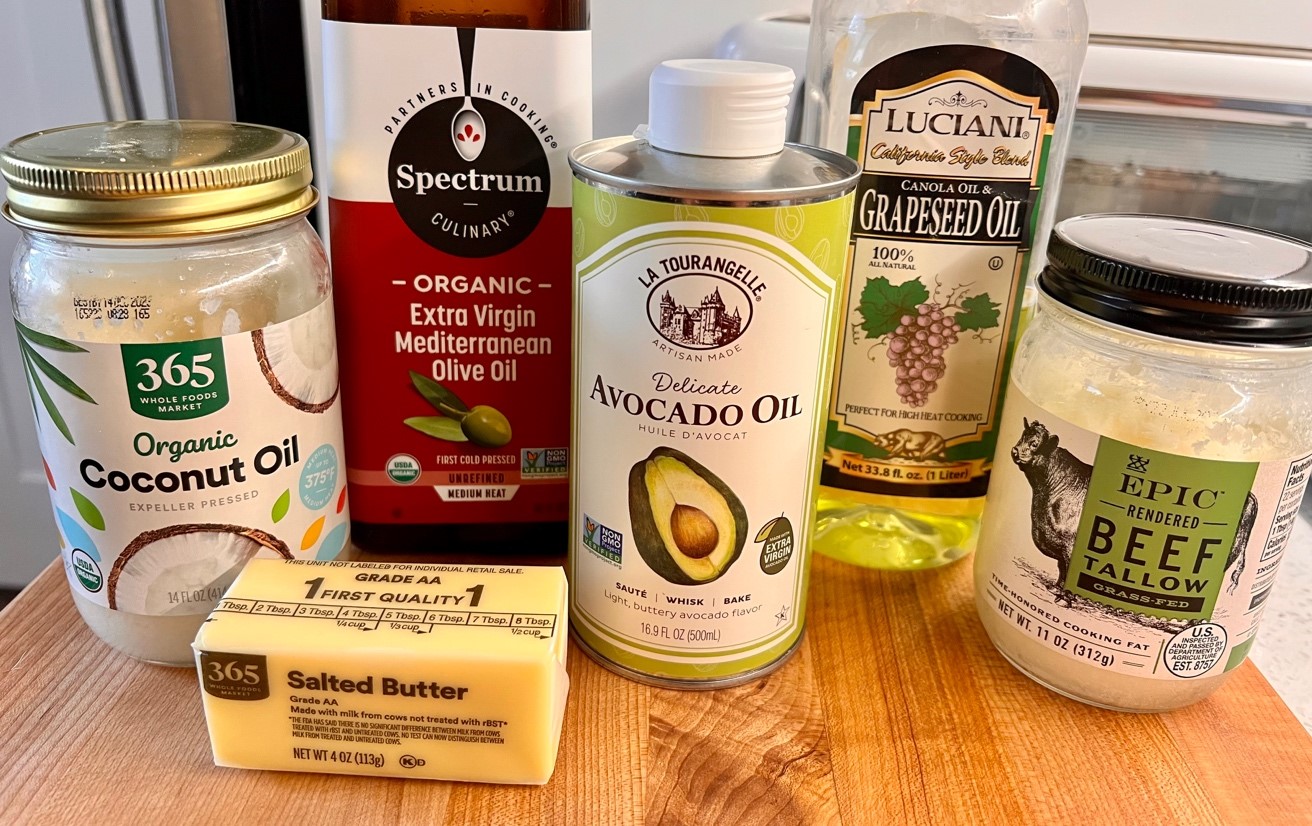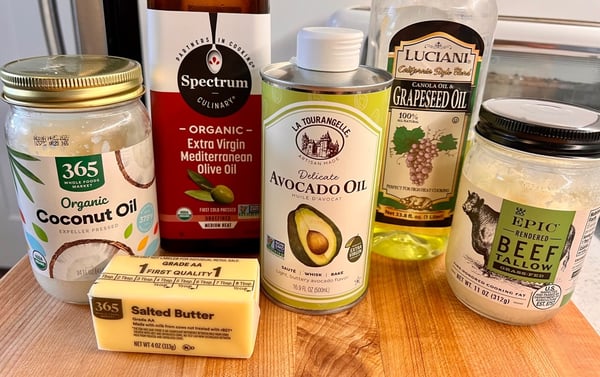
The world of cooking fats and oils (which are one and the same) can be as simplistic or as complex as you make it. Utilizing fat for cooking has many advantages, but overuse of fats can make a dish greasy or soggy. Too much oil can coat your pallet, making it hard for other flavors in the dish to show through on your taste buds. However, with the proper usage and amount, oil acts as a conductor of heat and can add color, crispiness, and flavor that is otherwise unachievable.
Fat is essential in baked goods & pastries, it is what gives them flakiness and aids in moisture. In savory cooking, fat is a must for searing and grilling as well as frying methods to get crisp golden-brown texture. In many cases, it acts as a release or non-stick coating especially when cooking proteins. Not to mention fat is crucial in roux and many emulsifications.
Contrary to popular opinion, I personally find more flavor and performance in saturated fats that are derived naturally and are minimally processed. That's opposed to (unsaturated) highly processed seed, vegetable and corn-based oils used in high quantity commercial cooking. These oils became popular for their low cost and abundance. Some seed oils like peanut or toasted sesame are great and full of flavor, but when I do use them, it is under low or no heat application more specifically to take advantage of the color, aroma and taste. I use olive oil in the same fashion - the attributes of these more delicate oils are lost when you heat them up beyond their low smoking points. The smoking point of an oil is the max temperature at which the oil begins to smoke and burn. At this point, the quality of the oil starts to quickly degrade and break down, and for this reason it’s important to pick the right oil for the cooking task at hand. This blog provides a brief overview of some of my favorite cooking fats and their ideal uses.
 Grapeseed Oil: high smoke point and most economical as far as price. With a neutral flavor profile, it works for dressings and marinades but is perfect for high heat sautéing and grilling. Makes a good lubricator/sealer when cleaning and maintaining cast iron pans and grill grates. Perfect general-purpose oil and is easily substituted for canola oil.
Grapeseed Oil: high smoke point and most economical as far as price. With a neutral flavor profile, it works for dressings and marinades but is perfect for high heat sautéing and grilling. Makes a good lubricator/sealer when cleaning and maintaining cast iron pans and grill grates. Perfect general-purpose oil and is easily substituted for canola oil.
Avocado Oil: high smoke point and derived from more natural processing. It’s light in body with buttery avocado flavor notes. Use this in place of grapeseed or canola for sauté, grilling, or even baking. Beware of cheap substitutions that are typically blended with cheaper oils as filler.
Beef Tallow: rendered fat from beef kidney and other parts of the steer. Make it at home by slowly heating to render the fats down, or speak to your butcher about purchasing the fat in bulk. It can also be found in the cooking oil aisle of some grocery stores. Has a high smoking point and is ideal for searing or shallow frying. Mild in savory beef flavor. This is my go-to for searing proteins.
Pork Lard: great for baking & pastry for its rich in flavor. Wonderful for deep or shallow frying and ideal for confit preparations aka slow cooking in fat. High smoke point.
Coconut Oil: wonderful in baking and vegan options for its notes of sweet coconut, medium-high smoke point. Versatile as it solidifies when cold but also melts down easily.
Ghee: similar to the traditional French method of clarifying butter, however in the case of ghee the butter is cooked until the milk solids are lightly browned before separating off the fat from the solids to give it a nutty flavor and aroma. Ghee/clarified butter can be used interchangeably and are great for high heat cooking and shallow frying. You get the rich flavor of butter and there's no worry about burning the milk solids.
Olive Oil: low heat cooking only. Lovely for finishing dishes, raw marinades, dressings, desserts, and raw preparations. Bringing your olive oil to high heats diminishes its quality, flavor, color, and texture. Extra virgin oils can be rich, floral, and have a wide range of body and flavor. It’s worth using a nice quality olive oil, so be careful of low quality blended options. As an option you can also cut or blend a high smoke point oil with your lower smoke point oils to actually increase their smoking point slightly if you are looking for a specific flavor profile.
Personally, I have all of these oils and more in my arsenal, but if you’re looking to start somewhere, I’d recommend avocado oil or grapeseed oil, especially if you currently use olive oil for any high temp cooking. If steaks are your thing or you do a lot of cooking in cast iron, definitely seek out the beef tallow! For fans of baking and pastry, try cutting in some lard instead of butter to see the difference in richness and flavor.
For more information on cooking with fats, check out Executive Chef Lisa Count’s blog on deep frying. Or join just about any of our cooking classes, especially Culinary Boot Camp, where you’ll get a great overview on the utilization of different fats and cooking oils.

